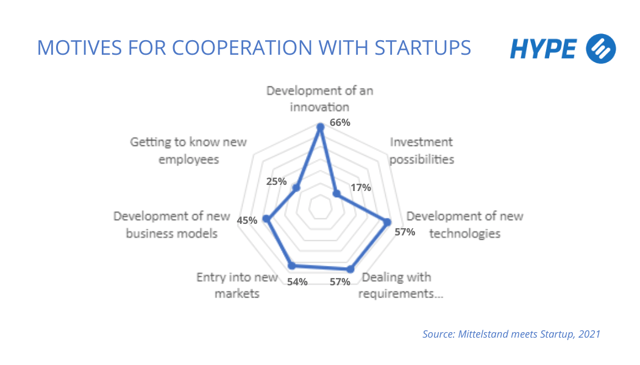Scaling Startup Scouting: Strategies for Identifying and Partnering with High-Potential Ventures
Learn about the concept of startup scouting and why it is so important for the growth of your business
Subscribe to the HYPE Innovation Blog
Throughout history, we’ve witnessed the power of innovation. Think back to the great industrial revolutions—the moments that propelled societies forward and ushered in unprecedented progress. Each revolution was fueled by visionary individuals who dared to think differently, to challenge the status quo, and to take bold risks. These pioneers were akin to the startups of their time—small, agile entities that disrupted entire industries and forever altered the course of history.
In today's business landscape, the story remains the same. Startups embody the spirit of those revolutionary thinkers, presenting corporations with an opportunity to tap into their groundbreaking ideas and fresh perspectives. Startups are the cradles of innovation, harboring the potential to transform industries, reshape markets, and redefine the rules of the game.
The pace of corporate disruption is on the rise. We're witnessing a fascinating shift where startups are overtaking established giants. In fact, a staggering 52% of S&P500 companies have vanished into thin air over the past 15 years. That's right, over half of these once-prominent players have succumbed to the winds of change. And it’s predicted that within the next decade, half of today's S&P500 firms will be replaced. A whole new era of business dynamics is unfolding before our eyes, where adaptability and innovation are the keys to survival.
With that in mind, we’ve created a complete guide to how corporates can adjust to change and be prepared for what’s ahead, instead of hoping for the best or sticking to the same old ways that most likely aren’t working anymore. We explore how corporates can work together with these new and emerging businesses instead of fighting them and delve into the essence of what partnering with startups is and how to scout them. From understanding the core principles to developing effective strategies, our guide should help to equip you with the knowledge and tools to navigate the vast landscape of startups and how to form a successful partnership with them.

What is Startup Scouting?
Startup scouting is an invaluable skill that can unlock a world of opportunities for businesses seeking growth and innovation.
In essence, startup scouting is the practice of actively searching for and evaluating early-stage companies with high potential for success. It's like being a keen observer, always on the lookout for the next big thing.
By engaging in startup scouting, businesses can tap into a wellspring of fresh ideas, disruptive technologies, and entrepreneurial talent. Startups often challenge the existing status quo as well as established norms, bringing novel solutions and approaches to addressing market needs—something that big corporates are not always capable of doing themselves in the face of complicated processes and extensive bureaucracy.
So, startup scouting enables businesses to expand their horizons and inject new life into their operations, offering an avenue for collaboration and partnership, where established companies can join forces with startups to leverage each other's strengths.
But startup scouting isn’t purely focused on finding opportunities for collaboration. It can also be a valuable source of market intelligence. Startups often act as a radar for emerging trends, untapped customer segments, or new technologies. By keeping a close eye on the startup ecosystem, businesses can stay informed about what’s happening in the market, how customer needs and preferences are evolving, and new potential market shifts and disruptions.
Why are Startups Important for Your Business?
Let’s take a quick survey. Would you agree with one of the following statements?
- You can either disrupt or be disrupted.
- The only constant is change.
- The rate of change is increasing.
- If you don’t disrupt the market, someone else will.
If you agree with one or more of the statements above, then you already understand the value of incorporating startup scouting into your open innovation strategy, the importance of not just depending on innovation from within your company, and the need to innovate beyond only incremental change. Above all, it’s critical to harness innovation from the outside.
Here are some thought-provoking statistics (Mittelstand meets Startup, 2021) on the main motives for cooperating with startups:
- 66%: Development of innovation
- 57%: Development of new technologies
- 57%: Dealing with requirements outside core competencies
- 54%: Entry into new markets
- 45%: Development of new business models

“Corporates should engage with startups across all phases […] to strengthen [their] market position in an increasingly competitive global marketplace. “
Source: McKinsey & Company. Karel Dörner, Max Flötotto, Tobias Henz, and Tobias Strålin. Europe’s innovation wunderkinds: The rising B2B start-up ecosystem. 14 April 2021
Collaboration and partnerships are the lifeblood of success in today's interconnected world, and startup scouting offers the key to unlocking these invaluable connections. By joining forces with startups, corporations can tap into shared resources, expertise, and complementary capabilities. These partnerships are like symbiotic relationships, where both parties thrive and flourish. Together, they can co-develop innovative solutions, penetrate new markets, and tap into previously untapped customer segments. It's a win-win scenario where the sum is greater than its parts.
How to Conduct Effective Startup Scouting
Every great collaboration needs to follow three essential phases: discovery, piloting and adoption.
Phase 1: Discover
Here's how to sharpen your discovery phase. Start with answering the following questions.
- What’s your motive?
As with any other process, scouting starts with understanding what your goal is and what problem you’re trying to solve.
Write a short overview of the situation, like you’d do when creating a brief for any other project. Think about the use case. Are you looking to invest, partner, or take over the startup?
- What field are you looking for startups in?
What’s your core interest? Would you be willing to expand your horizons and environment outside of your core interest? Are you looking for a particular piece of technology or solution? If you don’t yet know, describe the use case and keep an open mind when it comes to finding the right solution.
- How can you narrow down your search?
There are thousands of new startups out there. Anything that would help you to narrow down the search will be invaluable for your startup scouting process. Think about the location or geographical area. Is where the company is located important to you? Try to define the size and the growth stage of the company. How much funding should they already have and how many investment rounds should they have gone through? Is there anything else that’s important? Their founding year, for instance.
- Do you know any relevant startups already?
Next, think about relevant startups that come to mind. Maybe you know exactly which company would be a perfect fit for you. Or maybe you know from the outset which startups you should definitely exclude from your search.
Having this extensive brief and search criteria is a critical component of the scouting process. Try to be as specific as possible.
- Where and how can you discover startups?
In the discovery phase, make sure you leverage your existing networks and partnerships. Establish and nurture connections with relevant stakeholders, such as venture capitalists, angel investors, incubators, and accelerators. These networks can provide valuable insights and introductions to promising startups that fit your defined criteria. Collaborate with universities, research institutions, and industry associations to tap into their startup ecosystems.
You can also utilize online platforms and databases. These platforms allow you to search for startups based on your criteria. Use advanced search filters to narrow down your options and focus on startups that align with your objectives.
Attending startup pitch events and competitions is also worthwhile. Participate in startup pitch events, hackathons, and competitions. These events offer opportunities to see startups present their ideas, products, and services. You can gain helpful insights into the startup ecosystem, connect with founders, and assess their potential.
Phase 2: Pilot
After the discovery phase, you’ll have a list of potential candidates for collaboration.
Conduct thorough evaluations to assess their viability. Evaluate their business models, technology readiness, intellectual property, market potential, team capabilities, and financial health. Seek input from relevant stakeholders within your organization to ensure that you carry out a comprehensive assessment.
The piloting phase should produce a common understanding of the partnership’s working model, aligning with a common vision and objectives. Each use case can be very different, so this step is a crucial part of every new partnership project and forms the basis of establishing a clear and collaborative way of working together. By combining resources and competencies, a first collaborative MVP (minimal viable product) can be developed to mutually benefit the partners.
Phase 3: Adopt
In the adoption phase, establish a self-sustaining partnership and product. Transfer your collaborative product or service from a pilot to the real-world business context. Both partners should agree on a scaling strategy to create long-term value. Assign and clearly delineate tasks and responsibilities.
To transform your pilot project into a functioning and self-running working model, funnel your startup partners into your innovation management platform to create new, innovative products or services for existing or new markets.
Success Story: GELITA AG Creates a Scalable Startup Scouting Process
Founded in 1875, family-owned company GELITA AG is the world’s leading supplier of collagen proteins for the food, health, nutrition, and pharmaceutical industries. With over 140 years of experience and expertise, innovation has remained a driving force of the business. GELITA made the decision to look for innovative ideas and solutions outside of the company rather than just relying on internal resources to remain competitive.
The team overseeing the GELITA Innovation Scouting Program used corporate partnership management software to scout, identify, filter, and shortlist the most suitable startups for their business needs at scale.
Find out more about their case study here.

Best Practices for Startup Scouting
If you’re already on the journey to finding the best startups to partner with, here are some of the best practices shared by our own innovation experts working in our open innovation consultancy team.
Foster a startup-friendly culture: Your actions and strategy are important but the environment and culture in which you operate matters too. Create an organizational culture that values and embraces collaboration with startups. Encourage employees to engage in startup scouting and provide resources and support for their initiatives.
Leverage diverse networks: The more diverse your network is, the higher the likelihood that you’ll uncover unique and valuable companies to collaborate with. So start by engaging with venture capitalists, angel investors, incubators, accelerators, and industry associations as well as universities, research institutions, and innovation hubs to access their startup ecosystems. These networks can provide valuable insights and introductions to promising startups.
Utilize open innovation platforms and databases: There are a number of platforms specifically built for startup discovery. Platforms like HYPE Partnering, Crunchbase, AngelList, LinkedIn, and other specialized industry directories enable you to search for startups based on various criteria. Leverage advanced search filters to narrow down your options and focus on startups that match your innovation goals.
Due diligence is key: Before engaging with startups, conduct comprehensive due diligence to evaluate their viability. Assess their business models, market potential, technology readiness, team capabilities, intellectual property, and financial health. Engage relevant stakeholders within your corporation to gain diverse perspectives and ensure a comprehensive assessment.
Seek partnerships, not just solutions: Look beyond immediate solutions and focus on building long-term partnerships with startups. Evaluate their potential as strategic collaborators who can bring continuous innovation to your organization. Assess factors like shared values, alignment of visions, and cultural compatibility to ensure fruitful collaborations.
Create a single “source of truth”. Manage all your partnerships in one centralized place to create a single source of truth for all internal and external stakeholders. This should avoid duplication of effort, miscommunication, and repetitive status updates across multiple communication channels.
Final Thoughts
The success of your startup scouting depends crucially on your ability to scale your processes. As with any other process, multiple stakeholders, including external ones, will be involved in your startup scouting. Managing relations and expectations is easier and more effective if you know exactly what you’re trying to achieve if you have clear processes in place if you monitor the startup ecosystem regularly rather than on an ad-hoc basis, and if you know how to validate use cases and analyze feasible larger-scale deployments.
To learn more about startup scouting and how HYPE Partnering can facilitate the process to make it effective and easy to manage, please download our playbook or reach out to our startup-scouting experts via this contact form.

We make software that helps companies connect people with ideas, to drive innovation and transformation forward.

The HYPE Newsletter - Send me updates
Please keep me posted on Hype’s latest new product features and innovation management insights.


